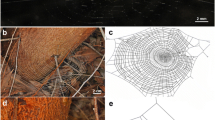Summary
When threatened, the black widow spider, Latrodectus hesperus, emits an adhesive, viscous web, pulls the strand from its spinnerets with its fourth pair of legs, and spreads its appendages. This behavior positions the web over the delicate abdomen, increases the area of protection, and enables the spider to place the web onto the offender, if necessary.
In laboratory interactions, the viscous web protected black widows from mice (Peromyscus spp.). Mature female spiders, which had their spinnerets blocked and hence could not discharge the viscid silk, escaped less often than did black widows that were not experimentally altered.
The viscid silk is palatable to mice and it appears that the deterrent effect of the web is due solely to mechanical irritation.
The defensive behavior is elicited most often from mature females, which may suffer greater predation than other age groups. Males lose the ability to produce the defensive web at maturity and may shift their energy resources totally into reproductive effort.
Similar content being viewed by others
References
Barmeyer RA (1975) Predation on the isopod crustacean Porcellio scaber by the theridiid spider Steatoda grossa. Bull South Calif Acad Sci 74:30–36
Blair AW (1934) Life history of Latrodectus. Arch Intern Med 54:844–850
Bristowe WS (1931) Notes on the biology of spiders. VI. Spitting as a means of capturing prey by spiders. Ann Mag Nat Hist (Ser 10) 8:469–471
Brodie Jr ED, Johnson JA, Dodd Jr CK (1974) Immobility as a defensive behavior in salamanders. Herpetologica 30:79–85
Comstock JH (1948) The spider book, 2nd edn. Cornell University Press, Ithaca
Eisner T (1970) Chemical defense against predation in arthropods. In: Sondheimer E, Simeone JB (eds) Chemical ecology. Academic Press, New York, pp 157–210
Falls JB (1968) Activity. In: King JA (ed) Biology of Peromyscus. Spec Publ Am Soc Mammal 2: 543–570
Gallup GG (1974) Animal hypnosis: factual state of a fictional concept. Psychol Bull 81:836–853
Herms WB, Bailey SF, McIvor B (1935) The black widow spider. Calif Agric Exp Stn Bull 591:1–30
Jellison Wl, Phillip CB (1935) The biology of the black widow spider. Science 81: 71–72
Kaston BJ (1970) Comparative biology of the American black widow spiders. Trans San Diego Soc Nat Hist 16:33–82
Kaston BJ (1972) How to know the spiders, 2nd edn. Brown, Dubuque, Iowa
Kovoor J (1977a) Donnees histochimiques sur les glandes séricigènes de la veuve noire Latrodectus mactans Fabr. (Araneae, Theridiidae). Ann Sci Nat Zool (Ser 12). 19:63–87
Kovoor J (1977b) La soie et les glandes séricigènes des Arachnides. Ann Biol 16:97–171
Lamoral BH (1968) On the nest and web structure of Latrodectus in South Africa and some observations on body coloration of L. geometricus (Araneae: Theridiidae). Ann Natal Mus 20:1–14
Landry Jr SO (1970) The rodentia as omnivores. Q Rev Biol 45:351–372
Masters WM (to be published) Insect disturbance stridulation: its defensive role. Behav Ecol Sociobiol
McAlister WH (1960) The spitting habit in the spider, Scytodes intricata Banks (Family Scytodidae). Tex J Sci 17:20
Millot J (1929) Sur le glande céphalothoracique d'une Araignée (Scytodes thoracica, Latr.). CR Acad Sci (Paris) 189:119–120
Sekiguchi NL (1955a) Differences in the spinning organs between male and female adult spiders. Sci Rep Tokyo Kyoiku Daigaku [B] 8:23–32
Sekiguchi NL (1955b) The spinning organs in sub-adult geometric spiders and their changes accompanying the last moult. Sci Rep Tokyo Kyoiku Daigaku [B] 8:33–40
Szlep R (1965) The web-spinning process and web structure of Latrodectus tredecimguttatus, L. pallidus and L. revivensis. Proc Zool Soc (London) 145:75–89
Wickler W (1968) Mimicry in plants and animals. McGraw-Hill, New York
Author information
Authors and Affiliations
Rights and permissions
About this article
Cite this article
Vetter, R.S. Defensive behavior of the black widow spider Latrodectus hesperus (Araneae: Theridiidae). Behav Ecol Sociobiol 7, 187–193 (1980). https://doi.org/10.1007/BF00299363
Received:
Accepted:
Issue Date:
DOI: https://doi.org/10.1007/BF00299363




